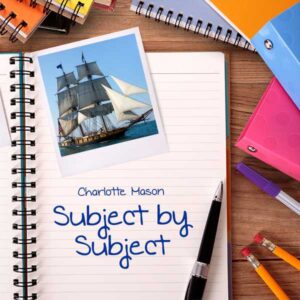Free shipping on USA orders over $129!


When I graduated from “the school of the yellow bus,” I knew next to nothing about history. Yes, I had made good grades, but very little about history had stuck. There was no reason to retain that mental list of events and dates past the test day, because I had no personal relation with those events or historical figures. They didn’t matter to me. Maybe you can relate.
Thankfully, over twenty years of homeschooling in a Charlotte Mason way, I have developed an appreciation for history and personal relations with the people involved. How? By using Charlotte’s methods of teaching history, I have learned along with my children and enjoyed doing it!
So, let’s talk about how to teach history.
Teaching History So It Means Something
In a Charlotte Mason education, history is taught through living books, narration, and a Book of Centuries.
Living Books
Living books are a key component to teaching many subjects in the Charlotte Mason Method, and history is one of them. A living book is a book that makes the subject come alive. It is usually written by one author who has a passion for the subject, rather than by a committee who has been hired to dispense facts in a textbook. A living book touches your emotions and fires your imagination, making it easy to see in your mind’s eye the events that are being described. The facts are there, but they are clothed in those living ideas that make the events stand out in your mind.
There are all kinds of great living history books available. The CM Bookfinder on our website is a database full of living books that you can search by title, grade level, topic, and more. You’ll find hundreds of living history books there.
If you want to see our favorites, take a look at the SCM Curriculum Guide. We’ve listed our top picks there, organized by grade level and time period for history.
To learn more about living books, feel free to spend a little time in our Learning Library. There you will find all kinds of articles on many topics. You’ll be able to read more on choosing good living books, using them, where to find them, and grasping that concept of living ideas vs. dry facts.
Narration
So you select a wonderful living history book and you read a portion of it to your student. Then what do you do? You require the child to narrate. He should tell back in his own words everything he can remember from the reading.
Narration demands a much higher thinking level than true/false, multiple choice, or fill-in-the-blank questions. You are asking the child to pay full attention and to compose a mental essay, in a sense.
Narration may seem easy until you try it for yourself. Charlotte encouraged adults to narrate in order to help them learn too. When you understand the power of narration, you will see why Charlotte used it in teaching many subjects.
While you’re in the Learning Library, look for the articles on narration too. You’ll find lots of great help and encouragement with this simple but powerful method.
Another resource that you might find helpful is the practical book, Your Questions Answered: Narration.
Book of Centuries
The third tool that Charlotte used in teaching history is the Book of Centuries. It’s basically a timeline in a book, organized in 100-year increments. As you read about (and narrate) people and events in history, jot them down on the appropriate pages in the Book of Centuries.
The genius of this idea comes to light when you add a person to a page that already contains someone or something that occurred in the same century. Now your brain makes the connection: “Oh! He lived at the same time as _____.” A connection that your child makes for himself will have the deepest impression and last the longest. And a Book of Centuries is a prime tool for helping your child make those mental connections.
When the children are old enough, each should have his or her own Book of Centuries. Charlotte’s students received theirs at about ten years old. During the younger years, you can compile a family Book of Centuries.
My Book of Centuries (yes, the parent should have one too!) has become a great companion and record of the fascinating people I’ve met through living history books. Now history makes sense!
You can create your own, using our free basic Book of Centuries template or purchase the ready-made deluxe version, My Book of Centuries.
Teaching Tip for History
Charlotte recommended that history be taught in chronological order, which makes sense since so much of what happened was based on cause and effect. So make sure you work your way through history sequentially, but don’t feel like you need to force other subjects to coordinate with the time period you happen to be studying.
Charlotte advocated natural connections, like history and geography. But you don’t have to limit your art study, let’s say, to your current historical period. You can select artists from a variety of eras with distinctly different styles. The key is to enter them into your Book of Centuries as you go along. Then when you progress to that point in history, your child will have a wonderful opportunity to make a mental connection when he sees that “old friend” looking out at him from that century’s pages.
Whether history is your favorite subject or a lot of forgotten dates from days gone by, you can enjoy watching it come alive alongside your children when you use Charlotte’s wonderful methods of living books, narration, and a Book of Centuries.
Podcast: Play in new window | Download
